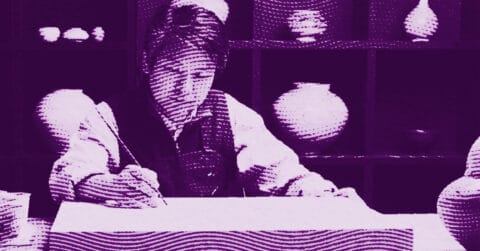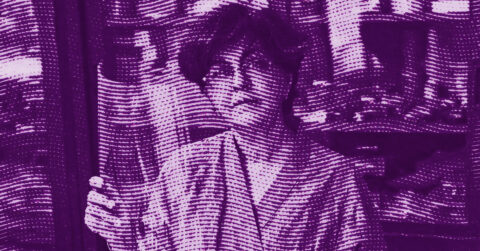Listen to me carefully, you bunch of snobs. In the sterile arena of contemporary Chinese art, where conceptual ease and serial production reign supreme, Xia Yu emerges as a singular being, an artist who obstinately refuses to conform to market dictates. His tempera paintings on wood or canvas transport us to a fascinating in-between, neither entirely past nor completely present, suspended in an indefinite space-time that captivates us without letting go.
The works of Xia Yu inevitably evoke those old yellowed photographs found in family albums, the ones that bear the weight of years and buried memories. These blurry, almost hazy images where characters seem to float in a bath of diffuse light, like apparitions from another time. But don’t be fooled, this is not about cheap nostalgia or retro styling. What Xia Yu does is much more subtle and relevant.
Born in 1981 in Anhui province, this former student of the Central Academy of Fine Arts in Beijing made a radical choice by adopting tempera as his preferred medium. This choice is not trivial, as this ancient technique dating back to Greek and Roman antiquity requires patience, precision, and meditation. A technique that goes against the grain in our era of immediacy and instant gratification. While most contemporary painters seek the quick path, Xia Yu engages in a laborious process that requires time and effort.
But it is precisely in this deliberate slowness that the strength of his work resides. Take, for example, his emblematic painting “Picking Up Files” (2018): employees in suits, on their knees, picking up scattered documents on the floor. A banal scene at first glance, but under Xia Yu’s brush, it transforms into a powerful allegory of contemporary human condition. These bent, submissive bodies inevitably recall Millet’s “The Gleaners”, but transposed into the sterile and dehumanizing environment of the modern office.
The artist practices what I would call an “archaeology of the present”. He examines our daily life with the meticulousness of an entomologist, unearthing the hidden poetry in banality and revealing the underlying tensions that animate our ordinary existences. His work fits into a literary tradition that can be traced back to Georges Perec, that French writer who managed to elevate the infra-ordinary to the rank of study object. As Perec wrote: “What happens every day and returns every day, the banal, the quotidian, the evident, the common, the ordinary, the infra-ordinary, the background noise, the habitual, how to account for it, how to question it, how to describe it?” [1]. This question, Xia Yu answers it through his painting, by capturing those fleeting and seemingly insignificant moments that make up the fabric of our lives.
His series “Hand” is particularly eloquent in this regard. These small paintings, where only the hands are represented, become expressive microcosms that tell stories much more eloquent than certain monumental works. The hands as the “second face” of the individual, revealing what facial expressions, often controlled and polite in contemporary Chinese society, cannot express. A hand holding an empty cup, another folding an origami, so many ordinary gestures that, isolated and magnified by the artist’s gaze, acquire an almost metaphysical dimension.
Xia Yu’s approach aligns with that of Italo Calvino and his “Lightness”. In his “American Lessons”, Calvino defines lightness not as an escape from the world’s heaviness, but as a different way of looking at it: “For me, lightness goes hand in hand with precision and determination, not with vagueness and abandonment to chance” [2]. This definition applies perfectly to the art of Xia Yu, who alleviates the weight of the everyday not by ignoring it, but by observing it with particular acuity.
This lightness is visually translated by Xia Yu’s use of light in his paintings. A light that does not so much illuminate as bathe the represented scenes, creating those characteristic blurry areas that give his works their particular atmosphere. In “Electric Bicycle, Sunset and Dog” (2021), the twilight envelops the protagonists in a golden aura, transforming an ordinary urban scene into a suspended, almost magical moment. This treatment of light evokes analog photography, with its imperfections and happy accidents, but also certain films by Wong Kar-wai, where light becomes a character in its own right.
But let’s not be mistaken: behind the apparent softness of Xia Yu’s images lies a sharp critique of contemporary Chinese society. His paintings stage individuals caught in the gears of a system that overwhelms them, torn between personal aspirations and social injunctions. Office scenes, in particular, function as metaphors for modern alienation. In ” 老板也忧伤 ” (“The boss is also sad”), a businessman contemplates his reflection in the polished floor, in a pose reminiscent of the Greek mythological Narcissus. An image that admirably condenses the vanity and solitude inherent in power.
This critical dimension brings Xia Yu closer to the tradition of social satire, found in both literature and visual arts. A parallel could be drawn with the work of American writer David Foster Wallace, particularly his novel “The Pale King”, which deals with boredom and alienation in a bureaucratic world. Wallace wrote: “True boredom, adult boredom, is something completely different. It is the most lonely experience possible, like no other” [3]. This essential solitude, Xia Yu captures it in his paintings of office employees, fixed in postures that evoke both submission and a form of passive resistance.
Cinema constitutes another major influence in Xia Yu’s work. His sense of composition and framing, his way of “cutting” reality to extract significant moments, all betray a certain cinematographic sensibility. One thinks in particular of the Japanese director Yasujirō Ozu and his way of filming daily life with an economy of means that does not exclude emotional depth. As film critic Donald Richie explains about Ozu: “He does not seek to impress the viewer with what he shows, but to move him with what he suggests” [4]. This remark applies perfectly to Xia Yu, whose art relies largely on suggestion and evocation rather than peremptory affirmation.
There is something profoundly subversive in this approach that seems so wise and measured. By choosing to paint scenes from everyday life with so much attention and care, Xia Yu affirms the intrinsic value of these ordinary moments that our hyperactive society pushes us to neglect. He invites us to slow down, to truly look at what surrounds us, to pay attention to the details that make up the very texture of our existence. And this invitation has something political in a world where speed is erected as the supreme value.
The very technique he employs, tempera, is part of this discreet resistance. At a time when contemporary artists vie for technological audacity, using virtual reality, artificial intelligence, and other digital tools, Xia Yu sticks to an ancestral method, slow and laborious. A choice that may seem anachronistic, but which acquires an almost heroic dimension in our context. As Susan Sontag wrote: “Heroism today would consist in refusing to be a hero, in refusing the seductions of a grandiose exceptionality” [5]. In this sense, Xia Yu’s art is profoundly heroic.
What I appreciate most about his work is the way he manages to create a form of silent communion between his characters and us, the viewers. These figures with often neutral, almost impassive expressions do not look directly at us, and yet we feel an intimate connection with them. Perhaps because we recognize in them our own daily struggles, our small defeats and our modest victories. Perhaps also because Xia Yu confers on them a dignity that modern life tends to refuse them.
I think in particular of that striking painting, “Sober” (2021), where a young man is depicted slumped on a table, visibly exhausted or drunk. A scene that could lend itself to mockery or judgment, but which Xia Yu treats with disarming tenderness. The soft light that bathes the character, the subtle and harmonious colors, everything contributes to creating an image of great humanity. We are far from the easy cynicism that characterizes so many contemporary works.
The art of Xia Yu reminds us that beauty can spring from the most ordinary circumstances, and that attention to the everyday can be a form of resistance in a world that values exceptionality and spectacle. As the English poet William Blake wrote: “To see a world in a grain of sand, And a heaven in a wild flower, Hold infinity in the palm of your hand, And eternity in an hour” [6]. This ability to perceive the extraordinary in the ordinary is at the heart of Xia Yu’s work.
What makes this artist strong is that he transcends easy dichotomies: tradition and modernity, East and West, personal and political. His work exists in that fertile in-between where contradictions do not resolve but coexist in creative tension. And it is precisely this ambiguity that makes his work so relevant to our time of faltering certainties and fluid identities.
So, you bunch of snobs, forget for a moment your prejudices about contemporary Chinese art and open yourselves to the subtlety and depth of Xia Yu. In an artistic world saturated with flashy and superficial works, his work offers a space for reflection and contemplation that we cruelly need. And if this seems too wise or too discreet for your tastes accustomed to excess, remember that sometimes, it is in the murmur that the most essential truths reside.
- Georges Perec, “L’Infra-ordinaire”, Éditions du Seuil, 1989.
- Italo Calvino, “Leçons américaines : Aide-mémoire pour le prochain millénaire”, Gallimard, 1989.
- David Foster Wallace, “The Pale King”, Little, Brown and Company, 2011.
- Donald Richie, “Ozu: His Life and Films”, University of California Press, 1974.
- Susan Sontag, “Regarding the Pain of Others”, Farrar, Straus and Giroux, 2003.
- William Blake, “Auguries of Innocence”, 1803.
















